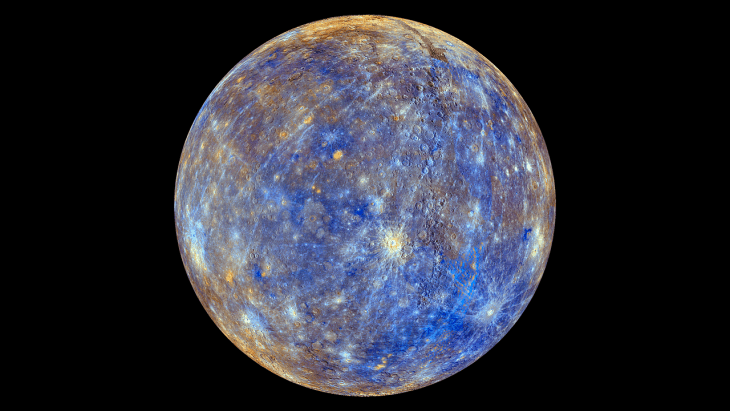
- Number of Moons: None
- Color: Dark gray
- Surface: Rocky surface, covered with a thick layer of dust
- Atmosphere: Composed of hydrogen, helium and oxygen
- Temperature: 801 Fahrenheit
- Made of: 70% of the planet is made of iron
- Distance from Sun: 43.5 million miles
- Discovered by: No single astronomer or scientist has been credited with its discovery
- Size: 3,030 miles
- Length of Day: 58d 15h 30m
- Astronomy: Mercury Is the Planet with the Most Extreme Temperature Fluctuations in the Solar System
- Astronomy: Mercury Is the Smallest Planet in the Solar System!
- Astronomy: Mercury Orbits the Sun Faster than Any Other Planet
- Astronomy: It Is Possible That Mercury Had Volcanoes in The Past
- Astronomy: Mercury Is One of 5 Planets You Can See Without a Telescope
- Geography: Mercury Is 57 Million Miles Away from Planet Earth
- Observation: Mercury Cannot Be Viewed from Hubble
- History: Copernicus Was the First Person to Actually View Mercury
- Astronomy: Your Weight Would Alter Drastically on Mercury
- Geology: The Center of Mercury Is Molten Iron
- Mercury Has a Crater Which Is 960 Miles Wide!
- Chilly! Scientists Have Discovered There Could Be Ice on Mercury
- Mercury Has the Thinnest Atmosphere of All the Planets
- Astronomers Wrongly Believed That Mercury Had A Smooth Surface!
- Mercury Has Strange “Tails” Exuding From its Surface
Mercury Facts Infographics

Mercury Is the Planet with the Most Extreme Temperature Fluctuations in the Solar System
The first of our interesting Mercury facts tells us all about its temperature. Although the planet is actually the closest to the Sun in the entire solar system, it is the plant that experiences the most extreme fluctuations of temperature. During the day, the surface temperature can reach as high as 840 degrees Fahrenheit, whilst at night it can drop as low as -279 degrees Fahrenheit. 840 degrees Fahrenheit is hot enough to melt lead!
Mercury Is the Smallest Planet in the Solar System!

Compared to many of the other planets in the solar system Mercury is very diminutive. It measures around 3,030 miles in diameter. For comparison, this measurement is about the same size as the continental United States. It was always thought that Pluto was the smallest planet, but in recent years it has been downgraded to become what is known as a dwarf planet instead, so Mercury now holds the honor of being the smallest planet proper.
Mercury Orbits the Sun Faster than Any Other Planet
The next of our interesting Mercury facts tells us about just how fast its orbit is. During the course of its orbit, the planet can get as close as 29 million miles to the Sun, and at its farthest it can be 43 million miles from the Sun. However, it also holds the distinction of being the planet that has the ability to travel the fastest around the sun, too. On average it takes only 88 days to complete its orbit, traveling at a speed of 112,000 miles per hour as it does so.
It Is Possible That Mercury Had Volcanoes in The Past

Large parts of the northern half of the planet have a very smooth surface. It is believed that this has occurred because lava may have poured over it at some point millions of years ago. There is no suggestion that there is any volcanic activity now, but scientists who study the planet think that this is the only explanation for the way the planet looks now. Some images of the planet show crater rings that look smoothed over and this gives further credence to the notion there may have once been volcanoes on the surface.
Mercury Is One of 5 Planets You Can See Without a Telescope
If you look to the sky, low down to the west (if you’re star gazing in the evening) or in the east (if you’re watching at dawn) you may be able to spot Mercury. It does not “twinkle” or shine like stars do and will appear duller in nature. The same goes for the other four planets you can see in the same way; Jupiter, Mars, Saturn and Venus.
Mercury Is 57 Million Miles Away From Planet Earth
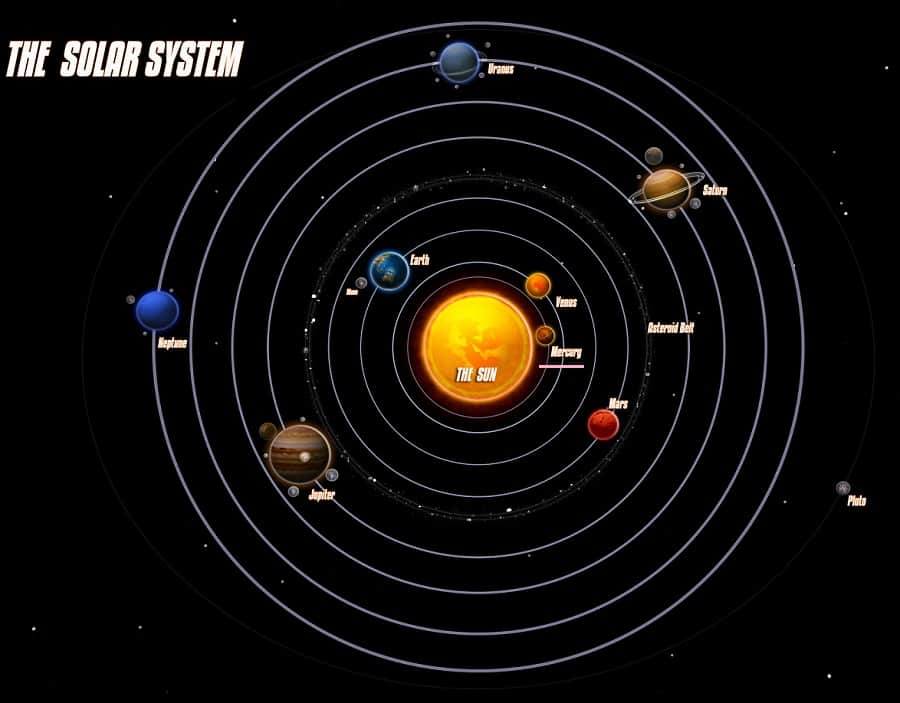
The next of our fascinating Mercury facts tells us about how far it is from Earth. It is 57 million miles away from us (92 million kilometers). Scientists measure the distances between planets using something called an Astronomical Unit (AU). Using this method of measurement, Mercury is estimated to be 0.61 AUs from Earth.
Mercury Cannot Be Viewed from Hubble

Another one of the interesting Mercury facts is that the planet cannot actually be viewed from the Hubble Space Telescope. This is because Mercury is positioned too close to the Sun. As the Sun is so bright, its light would actually end up damaging the sensitive electrical components that are built into the telescope itself.
Copernicus Was The First Person to Actually View Mercury
Although the discovery of Mercury cannot be attributed to one single person, it is widely believed that Copernicus (the renaissance astronomer and mathematician born in 1473) was the first person to view the planet in orbit during the very early stages of the 16th century. Galileo is believed to have been the next person to view Mercury over a hundred years later, in the 17th century.
Your Weight Would Alter Drastically on Mercury
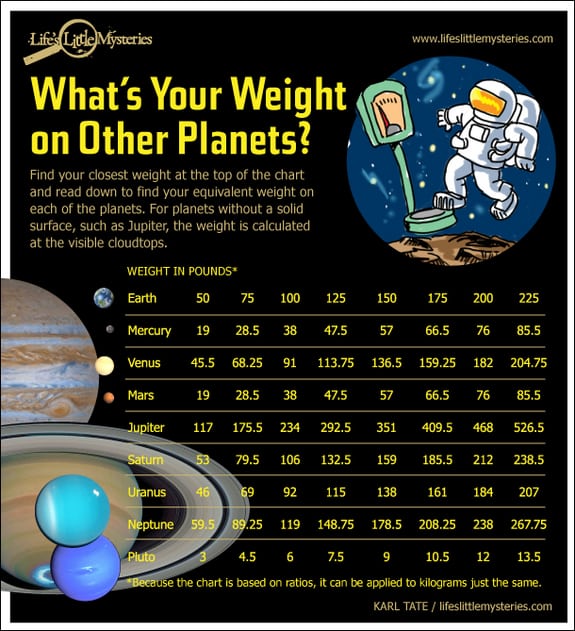
One of our most fascinating Mercury facts explains what would happen to our body weight if we were to visit the planet. If you were to land on Mercury you would weigh much less than you do on Earth. This has nothing to do with actually losing weight, but more to do with the fact that Mercury has much less gravity. To put it into context, if you weighed 100lbs on earth, but traveled to Mercury on a spaceship, you would only weigh 38lbs when you landed there!
The Center of Mercury Is Molten Iron
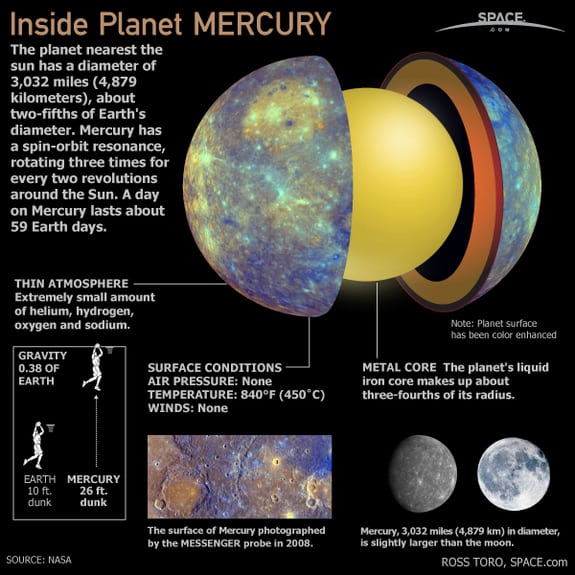
The core of the planet is made up of iron. Over many millions of years, it has cooled and started to contract. This fact is partly responsible for how the surface of the planet appears (wrinkled and cratered). However, astronomers now believe that the center of the planet has not cooled totally and that the very center of its core is still made up of molten iron.
Mercury Has a Crater Which Is 960 Miles Wide!
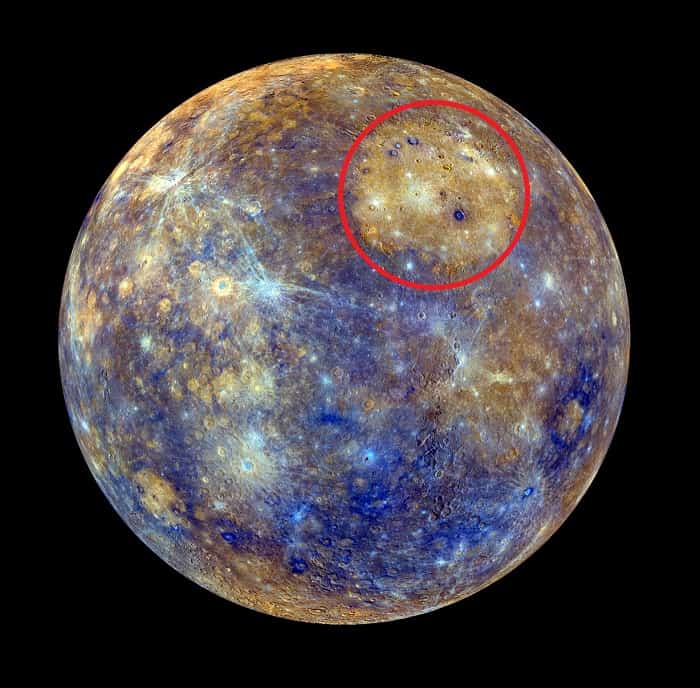
The next of our Mercury facts tells us about the planet’s appearance. Scientists believe a giant asteroid crashed into the surface of the planet around 4 billion years ago. It was called the Caloris Basin and it left a crater which is 960 miles wide. To put that into context – the entire state of Texas in the United States could fit into it. Scientists also were able to calculate that the Caloris Basin must have been at least 60 miles wide itself to be able to create such damage.
Chilly! Scientists Have Discovered There Could Be Ice on Mercury
It seems odd to think that a planet that has such high temperatures could also be home to ice, but scientists believe there is a strong possibility Mercury could have some of the cold stuff – and it is located inside its craters. The reason scientists believe this is because the planet’s north and south poles are very shadowy and their temperatures are very low. It is thought that these two facts make it possible the planet could retain water which could then ice over. Another possibility is that water has seeped out from inside the planet and frozen over – either way it goes to show that Mercury is a planet of contrasts
Mercury Has the Thinnest Atmosphere of All the Planets
The next one of our fascinating Mercury facts tells us about its atmosphere. It has the thinnest atmosphere of all the planets in the solar system. In fact, the atmosphere is believed to be so thin that scientists have had to come up with a completely new name for it. They have called the atmosphere on Mercury the exosphere. The moon and some of the other planets all have exospheres too, but Mercury is the only planet to have this phenomenon on its own.
Astronomers Wrongly Believed That Mercury Had A Smooth Surface!
Up until the year 1973, astronomers studying the planet thought it had a smooth surface. However, when the American Robotic Space Probe Mariner 10 flew by Venus and Mercury in that same year, it was discovered that Mercury is actually the most cratered planet in the solar system. The surface of Mercury is actually very similar to that of the Moon.
Mercury Has Strange “Tails” Exuding From its Surface
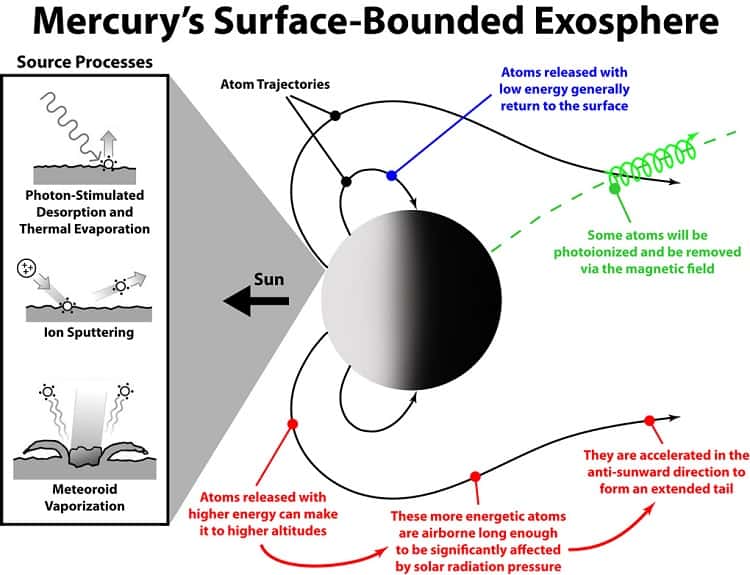
The last of our Mercury facts tells us about a strange phenomenon seen in the atmosphere near the planet. When Mercury has been examined closely by researchers from NASA, they have noticed that the surface of the planet has strange tails and trails that seem to come off its surface. These are trails of particles that float off into the air in a tail shape. NASA do not know why the particles take on this formation, but they think that it could be something to do with the magnetosphere that surrounds the planet, and the Sun’s wind
Mercury Facts – Facts About Planet Mercury Summary
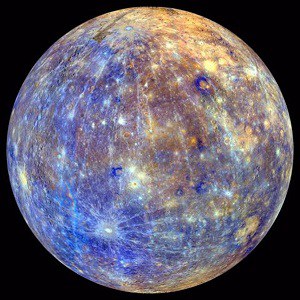 Facts about Mercury tell us that the planet has the most extreme fluctuations of temperature in the solar system, and that it may have had volcanoes on its surface in the past. These volcanoes may account for how the planet’s surface looks now. Mercury that has little to no atmosphere, and is the closest planet to the Sun in our solar system.
Facts about Mercury tell us that the planet has the most extreme fluctuations of temperature in the solar system, and that it may have had volcanoes on its surface in the past. These volcanoes may account for how the planet’s surface looks now. Mercury that has little to no atmosphere, and is the closest planet to the Sun in our solar system.
Was this page helpful?
Our commitment to delivering trustworthy and engaging content is at the heart of what we do. Each fact on our site is contributed by real users like you, bringing a wealth of diverse insights and information. To ensure the highest standards of accuracy and reliability, our dedicated editors meticulously review each submission. This process guarantees that the facts we share are not only fascinating but also credible. Trust in our commitment to quality and authenticity as you explore and learn with us.
